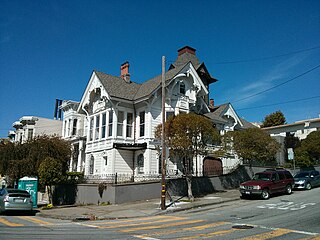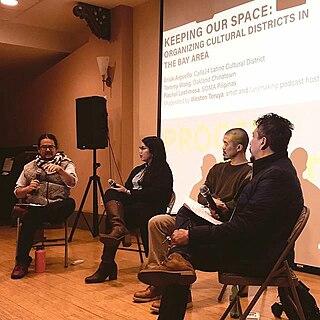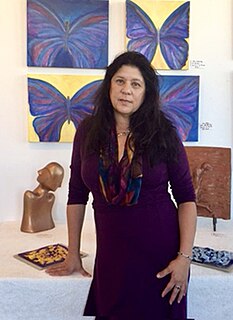Related Research Articles

Hetch Hetchy is a valley, a reservoir, and a water system in California in the United States. The glacial Hetch Hetchy Valley lies in the northwestern part of Yosemite National Park and is drained by the Tuolumne River. For thousands of years before the arrival of settlers from the United States in the 1850s, the valley was inhabited by Native Americans who practiced subsistence hunting-gathering. During the late 19th century, the valley was renowned for its natural beauty – often compared to that of Yosemite Valley – but also targeted for the development of water supply for irrigation and municipal interests. The controversy over damming Hetch Hetchy became mired in the political issues of the day. The law authorizing the dam passed Congress on December 7, 1913.

The Tuolumne River flows for 149 miles (240 km) through Central California, from the high Sierra Nevada to join the San Joaquin River in the Central Valley. Originating at over 8,000 feet (2,400 m) above sea level in Yosemite National Park, the Tuolumne drains a rugged watershed of 1,958 square miles (5,070 km2), carving a series of canyons through the western slope of the Sierra. While the upper Tuolumne is a fast-flowing mountain stream, the lower river crosses a broad, fertile and extensively cultivated alluvial plain. Like most other central California rivers, the Tuolumne is dammed multiple times for irrigation and the generation of hydroelectricity.
Environmental art is a range of artistic practices encompassing both historical approaches to nature in art and more recent ecological and politically motivated types of works. Environmental art has evolved away from formal concerns, for example monumental earthworks using earth as a sculptural material, towards a deeper relationship to systems, processes and phenomena in relationship to social concerns. Integrated social and ecological approaches developed as an ethical, restorative stance emerged in the 1990s. Over the past ten years environmental art has become a focal point of exhibitions around the world as the social and cultural aspects of climate change come to the forefront.
White Fungus is an art magazine and project based in Taichung City, Taiwan. Founded by brothers Ron and Mark Hanson in Wellington, New Zealand, in 2004, as a quasi-political manifesto, copies of the first issue were produced on a photocopier, wrapped in Christmas paper and hurled anonymously through the entrances of businesses throughout the city. Now a magazine featuring interviews, writing on art, new music, history and politics, White Fungus takes a dialogical approach to the work it covers. The name of the publication comes from a can of “white fungus” the Hansons found in their local supermarket in the industrial zone of Taichung City. Each cover of White Fungus is derived from a scan of the can.

The Nightingale House is a Victorian era Queen Anne and Eastlake style house, located at 201 Buchanan Street in San Francisco, California, United States. The 4400 square foot home was designed by architect John Marquis and built in 1882. The name comes from its original owner, John Nightingale.

Favianna Rodriguez is an American artist and activist. She has self-identified as queer and Latina with Afro-Peruvian roots. Rodriguez began as a political poster designer in the 1990s in the struggle for racial justice in Oakland, California. Rodriguez is known for using her art as a tool for activism. Her designs and projects range on a variety of different issues including globalization, immigration, feminism, patriarchy, interdependence, and genetically modified foods. Rodriguez is a co-founder of Presente.org and is the Executive Director of Culture Strike, "a national arts organization that engages artists, writers and performers in migrant rights. "

Recology, formerly known as Norcal Waste Systems, is a waste management company headquartered in San Francisco, California. The company collects and processes municipal solid waste, reclaiming reusable materials. The company also operates transfer stations, materials recovery facilities (MRFs), a number of landfills, and continues to spearhead renewable energy projects. Recology is the largest organics compost facility operator by volume in the United States.
Ecological art is an art genre and artistic practice that seeks to preserve, remediate and/or vitalize the life forms, resources and ecology of Earth. Ecological art practitioners do this by applying the principles of ecosystems to living species and their habitats throughout the lithosphere, atmosphere, biosphere, and hydrosphere, including wilderness, rural, suburban and urban locations. Ecological art is a distinct genre from Environmental art in that it involves functional ecological systems-restoration, as well as socially engaged, activist, community-based interventions. Ecological art also addresses politics, culture, economics, ethics and aesthetics as they impact the conditions of ecosystems. Ecological art practitioners include artists, scientists, philosophers and activists who often collaborate on restoration, remediation and public awareness projects.

O'Shaughnessy Dam is a 430-foot (131 m) high concrete arch-gravity dam in Tuolumne County, California, United States. It impounds the Tuolumne River, forming the Hetch Hetchy Reservoir at the lower end of Hetch Hetchy Valley in Yosemite National Park, about 160 miles (260 km) east of San Francisco. The dam and reservoir are the source for the Hetch Hetchy Aqueduct, which provides water for over two million people in San Francisco and other municipalities of the west Bay Area. The dam is named for engineer Michael O'Shaughnessy, who oversaw its construction.

Weston Teruya is an Oakland-based visual artist and arts administrator. Teruya's paper sculptures, installations, and drawings reconfigure symbols forming unexpected meanings that tamper with social/political realities, speculating on issues of power, control, visibility, protection and, by contrast, privilege. With Michele Carlson and Nathan Watson, he is a member of the Related Tactics artists' collective and often exhibits under that name.
Linda Weintraub is an American art writer, educator and curator. She has written several books on contemporary art. Her most recent works address environmental consciousness that defines the ways cultures approach art, science, ethics, philosophy, politics, manufacturing, and architecture.

Aviva Rahmani is an Ecological artist whose public and ecological art projects have involved collaborative interdisciplinary community teams with scientists, planners, environmentalists and other artists. Her projects range from complete landscape restorations to museum venues that reference painting, sound and photography.

Ecofeminist art emerged in the 1970s in response to ecofeminist philosophy, that was particularly articulated by writers such as Carolyn Merchant, Val Plumwood, Donna Haraway, Starhawk, Greta Gaard, Karen J. Warren, and Rebecca Solnit. Those writers emphasized the significance of relationships of cultural dominance and ethics expressed as sexism (Haraway), spirituality (Starhawk), speciesism, capitalist values that privilege objectification and the importance of vegetarianism in these contexts (Gaard). The main issues Ecofeminism aims to address revolve around the effects of a "Eurocentric capitalist patriarchal culture built on the domination of nature, and the domination of woman 'as nature'. The writer Luke Martell in the Ecology and Society journal writes that 'women' and 'nature' are both victims of patriarchal abuse and "ideological products of the Enlightenment culture of control." Ecofeminism argues that we must become a part of nature, living with and among it. We must recognize that nature is alive and breathing and work against the passivity surrounding it that is synonymous with the passive roles enforced upon women by patriarchal culture, politics, and capitalism.
Bonnie Ora Sherk was an American landscape-space artist, performance artist, landscape planner, and educator. She was the founder of The Farm, and A Living Library. Sherk was a professional artist who exhibited her work in museums and galleries around the world. Her work has also been published in art books, journals, and magazines. Her work is considered a pioneering contribution to Eco Art.
The Peninsula Museum of Art (PMA) is a 501(c)(3) non-profit art museum located in San Bruno, California.
Jo Hanson (1918–2007) was an American environmental artist and activist based in San Francisco, California.

Terry Berlier is an artist and sculptor whose work addresses themes of the environment and queer practice.
Beverly Naidus is an American artist, author and current faculty member of University of Washington Tacoma. She is the author of several artist books including One Size Does Not Fit All (1993) and What Kinda Name is That? (1996) which has been discussed by academics in the field including Paul Von Blum, Lucy R. Lippard and reviewed by contemporary journals. She has received multiple grants including the Massachusetts Cultural Council Artist's Grant in Photography (2001) to fund her art creations and teaching. She was also a finalist in the Andy Warhol Foundation and Creative Capital's Art Writers Grant Program (2007). Her most recent book Arts for Change: Teaching Outside the Frame (2009) is her personal pedagogy on teaching and creating socially engaged art. She also provides suggestions on engaging students in what is most important to them.

Lori Kay also known as Lori Kay Stout is an American artist, educator and activist based in the San Francisco Bay Area. She is known for her sculptures made of bronze, mixed media and recycled materials. Her work sometimes addresses issues of racial identity or mixed racial identity or issues of environmental awareness. She is also the owner of the Lupin Lodge of Los Gatos, a clothing-optional resort.
References
- ↑ "About Us". Women Eco Artists Dialog. Retrieved 2013-08-12.
- ↑ Leibovitz Steinman, Susan. "JO HANSON: Pioneering Environmental Artist Dies in San Francisco". Green Museum. Retrieved 2013-08-12.
- ↑ "Green Arts Web: Artists & Projects". Carnegie Mellon University. Retrieved 2013-08-12.
- ↑ "Earthly Concerns, Activist EcoArt curated by WEAD" (PDF). University of San Francisco. Retrieved 2013-08-12.
- ↑ "CONVERGENCE/DIVERGENCE SYMPOSIUM". Los Medanos College. Retrieved 2013-08-12.
- ↑ "WEAD East I Women and the Environment". Kingsborough Community College. Retrieved 2013-08-12.
- ↑ Recology. "The Art of Recology". Recology. Retrieved 2021-05-27.
- ↑ Cohn, Terri. "Nature, Culture and Public Space". Purdue University. Retrieved 2013-08-12.
- ↑ "2010 Water Conservation Showcase Speakers Save Water by Going Paperless!". Pacific Gas and Electric Company. Retrieved 2013-08-12.
- ↑ "Greywater in California: Designing, Managing, Monitoring". TUOLUMNE COUNTY ENVIRONMENTAL HEALTH. Retrieved 2013-08-12.
- ↑ Lambe, Claire. "An Interview with Linda Weintraub – Curator of "Dear Mother Nature: Hudson Valley Artists 2012" at The Dorsky". Roll Magazine, Mark Gruber Gallery. Retrieved 2013-08-12.
- ↑ "To Life! Eco Art in Pursuit of a Sustainable Planet". University of California Press. Retrieved 2013-08-12.